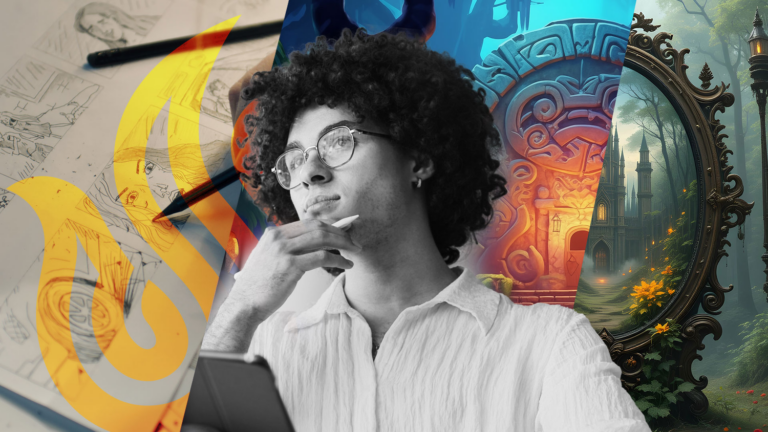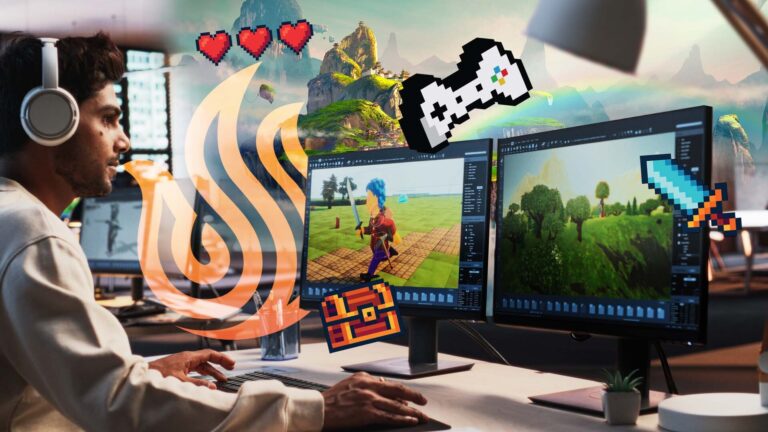If you’ve ever dreamed of creating art for your favorite video games, then you’ve probably had a moment where you wondered what why someone would become a game design artist. Although the video game industry is incredibly alluring, it is often wrapped in so much mystery that it can be difficult to know where to begin your research.
Why Become a Game Designer?
It takes a passion to design video games, and it takes perseverance to see the process through to the end to publish a completed game. Despite the challenges presented by game design, it is also a highly rewarding craft that provides fulfillment on a variety of levels.
Constant Learning and Expansion
The video game design process is constantly evolving in a multitude of ways. There will always be new software, hardware, and skill sets to learn. As a game design artist, you’re often one of the first people to explore these new technologies. So, the onus is on you to teach yourself and figure out the best practices as you go. This cycle is incredibly satisfying for those who love to acquire knowledge. One of the great joys of game design is seeing yourself improve steadily as your familiarity with the medium grows.
Rewarding Challenges to Conquer
Even after you’ve mastered your current design tools, creating games is an incredibly challenging endeavor. The process is very demanding, and most projects span several years. Most of the things taken for granted in modern titles require dozens of work hours filled with a lot of problem-solving. This is a dream come true for anyone who doesn’t want to be bored at work. The mind of a game design artist is constantly coming up with new solutions to issues that happen at a moment’s notice.
Recognition for Talent and Hard Work
Although the work can be tough, the arduous journey yields massive dividends if you see production through to the end. Video games are quickly becoming the most popular entertainment medium. Prolific game designers and artists who’ve cut their teeth in the industry are lauded by countless fans. Even if you are not called out by name, the games you work on can receive high praise from media outlets or even win awards. Adding these types of achievements to your resume provides more than enough credibility to expand your opportunities throughout the games industry.
The Ability to Do What You Love
There are many people who can’t honestly say they love what they do for a living. It is an immense boon to your mental health and quality of living when you can wake up excited to go to work each morning. If you truly love video games, then working on them provides tons of joy. Game design artists have the perfect creative outlet and get to express themselves on a daily basis.
Where Can You Work as a Video Game Artist?
There are plenty of great career opportunities for those who are proficient at video game art. In addition to the abundance of roles in the industry itself, many skills you will develop transfer over quite naturally to other disciplines. Here is a quick breakdown of the most common opportunities enjoyed by a game design artist.
High Profile Studios
A majority of video game artists strive to work on big budget titles for high profile development studios. These companies make games such as Call of Duty and League of Legends, that go on to sell millions of copies each year. Considering how much money there is to be made, there is a great deal of competition to determine who fills each position. The good news is that these studios employ massive teams that commonly eclipse 100 people. So, there is a constant flow of new opportunities for aspiring game design artists. Once you get your foot in the door, you can climb the ranks through impressive results.
Indie Development
Game design artists can also choose the indie route if they prefer to have more creative freedom over their work. Since high profile studios require tons of funding, they are beholden to the demands of their investors. Indie teams usually come together with a dream and very few resources. While the lack of funding can be challenging at first, indie development provides the game design artist with complete control of each project. These teams are usually small, and many indie games are created by a single person. If your newly released indie game becomes a hit, each team member enjoys massive profits.
Tabletop and Board Game Development
Believe it or not, plenty of video game artists get their start designing the visual elements for tabletop and board games. Both mediums share similar DNA and the audiences for each overlap quite a bit. Designing analog games is less daunting than creating an entire digital world. This makes it a great way for budding artists to gain the experience required to get their foot in the door at a video game studio.
Movies and TV
It is common for game design artists to venture out into new creative territory. After an illustrious career in games, many design artists decide to tackle a movie or television production. Considering the amount of computer-generated special effects in modern programming, the skills of a video game artist transfer with aplomb. Once an experienced game design artist gets familiar with movie production software, they can easily apply their talent to that medium.
Animation or Comics
Video game design artists often choose to work on animation or comic books as well. Much like movies, a large portion of a game design artist’s skills will transfer after a brief period of learning a new set of tools. Aspects of visual design remain congruent across almost all forms of entertainment. The game design artists can even draw great comics if they focus on their fundamental skill set.
Which Skills are Necessary to Succeed as a Game Design Artist?
Video game art can take the form of any style that you wish. There is an endless supply of skills and talents to accrue. You may even feel confident enough to invent an entirely new art style or genre. Although the possible directions you can go are endless, there are a few common traits and skills that all successful game design artists share.
Skill #1: Meticulous Attention to Detail
It is amazing just how much detail gets picked up by human senses. Think of the last time you felt a piece of art was off in some way but couldn’t express why. You were noticing an incorrect detail at the subconscious level. One of the hallmarks of great art is capturing the finer details of a piece. This makes the subject of your art more believable to the audience. As games offer more advanced graphics, even finer levels of detail are required to keep the game world from losing its immersion.
Skill #2: Clear Communication and Teamwork
While it is possible to create a whole game by yourself, nearly all titles are developed with a team. Whether you are working on a team of two or two hundred, you will need to communicate clearly and concisely. Clear communication gets your point across without any extraneous details. There will inevitably be a few disagreements throughout development. Effective communication is the best way to quell conflicts and keep the whole team on track.
Skill #3: Strong Work Ethic
Creating video game art is an extremely in-depth process that requires a huge time commitment. Game projects routinely take several years to finish so everyone working on a title needs to be in it for the long haul. Typically, the work schedule is more laid back during the initial stages of development. As the launch date approaches, everyone will need to work harder. A strong and consistent work ethic is needed to keep your head in the game for several years at a time. The upside to long development cycles is that many studios take breaks that last several months before returning to the grind for their next project.
Skill #4: A Vibrant Imagination
The main job of any game design artist is to translate their imagination into a tangible piece that can be observed by others. Having a strong connection to your imagination is crucial to being a great game design artist. Many games have their own universes that don’t resemble earth in the slightest. A game design artist must rely on their own creativity to invent new objects and characters that make sense within the context of that particular universe.
Final Thoughts
Becoming a video game design artist is an excellent option for you to consider. Each year video games continue to increase in popularity and the industry is growing exponentially.
If you want to get your work in front of as many people as possible, you will benefit the most from this expansion. Large development studios readily employ dozens of artists to keep up with the latest trends in graphical fidelity. Perseverance and a desire to keep improving is all you need to make it as a game design artist.
What are the reasons you want to become a game design artist? As the video game industry continuously grows, employers are zeroed in on Game Design Art Program students who understand both the creative and technical sides of the industry. Nowhere is University of Silicon Valley’s unique ability to combine specializations better demonstrated than in our Game Design & Development Department. All of our Game Design Art program students get hands-on experience working collaboratively in classes that simulate an actual game development team.
With two areas of degree program concentration—art and writing—the Game Design Art Degree program is your launchpad for a career in the creative side of game design. Focusing on environments, characters, story and more, you’ll learn how to create the elements that breathe life into the gameplay experience.
University of Silicon Valley is uniquely poised to offer a meaningful and valuable education for 21st century students. We believe in an education that directly correlates with the work you’ll be doing after you graduate. Interested in learning more? Contact Us today.


